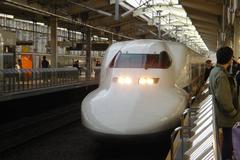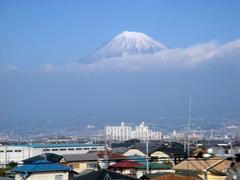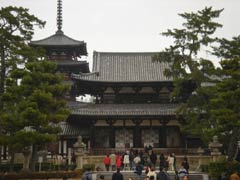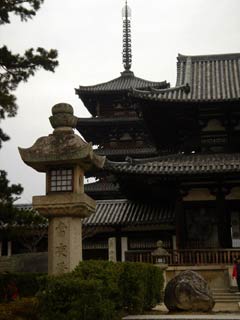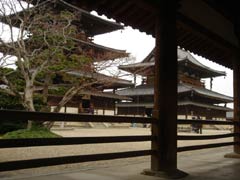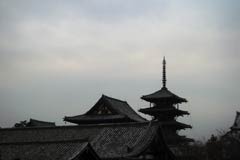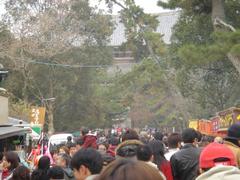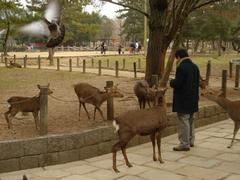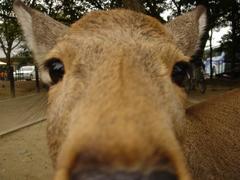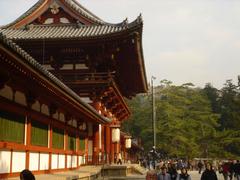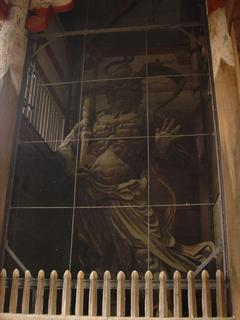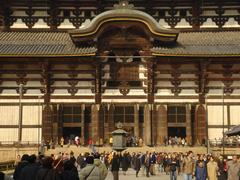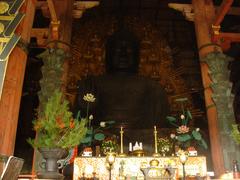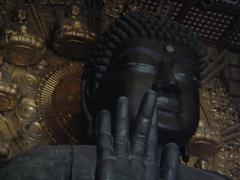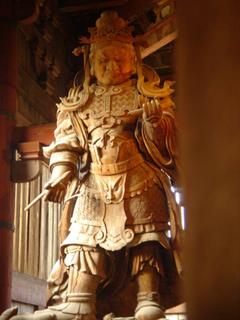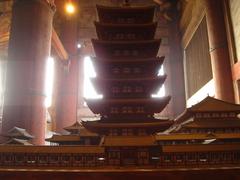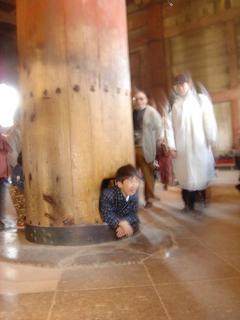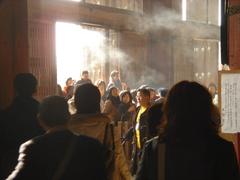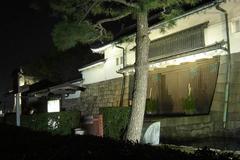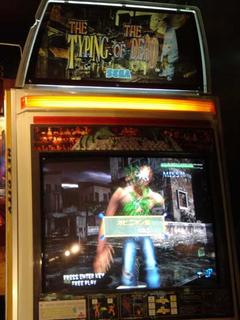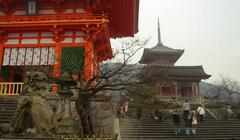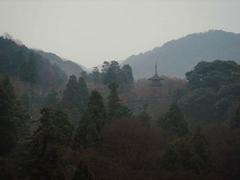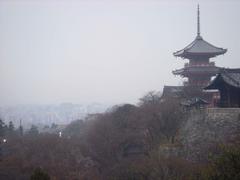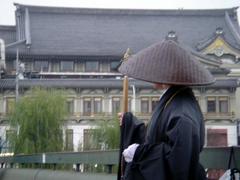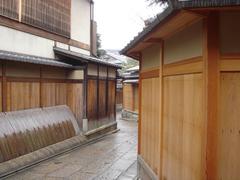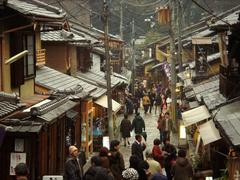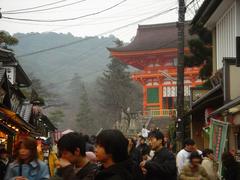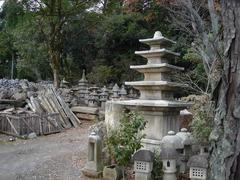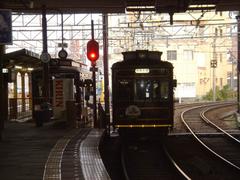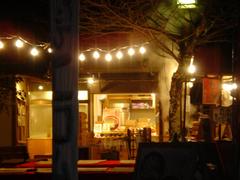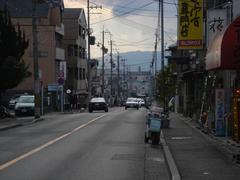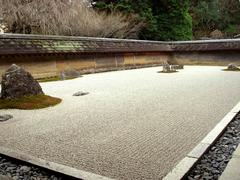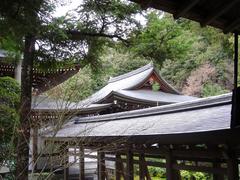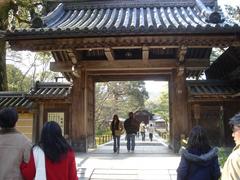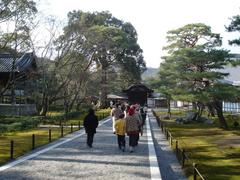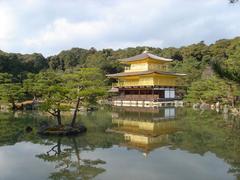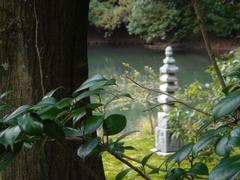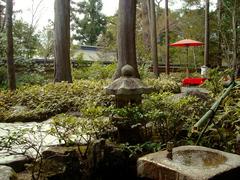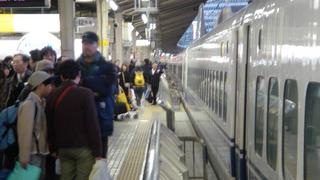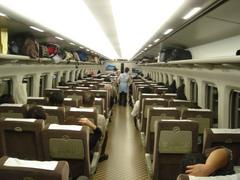Looking back, my Kyoto experience was probably the biggest trip I've taken in ages. Somehow, in four days, the Tanakas and I managed to hit every major cultural spot in the region and still had time for New Year's. I'll probably never see so much history in one week again.
And that was that. The next morning, the Tanakas took me to the station and bid me farewell. They were wonderful hosts who made me feel like part of the family, and I'm sure we'll meet again someday.
All of a sudden, I can't stop thinking about tunnels.
I assumed my sightseeing was over once I was comfortably on my way back to Tokyo, but my day had one last surprise in store for me. Halfway through the ride, I glanced out the window and saw something I'll remember for the rest of my days.
People, it's like no other mountain on earth.
A minute later, it was swallowed up by the clouds again. One more reason to ride the Shinkansen.
Emperor Yomei, ruler of Japan in the 6th century, was dying. Hopeful that Buddhism, a new religion recently arrived from Korea, could cure his ailments, he ordered the construction of an elaborate temple to show his devotion. Despite the fact that he died shortly thereafter, his wife and son spent the next 20 years completing the project, which strikes me as awfully nice of them.
Horyuji was drastically different from every other temple we went to, even before we got there. For one thing, it takes a half-hour bus ride through fields and tiny townships to get there. So it wasn't mobbed with tourists like the other places.
Horyuji, you see, is the only surviving temple from the era in which Nara was the capital of Japan. Thus it's not easily accessible like all the Kyoto and Tokyo monuments. The fact that it's still standing, 1300 years later, is nearly incomprehensible. It's the oldest wooden building in the world, and believe me, it commands respect.
It's hard to explain why this, of all places, is the temple I'd most recommend making the pilgrimage to see. It's not covered in gold. It's not guarded by cool statues. It doesn't have its own lake or elaborately landscaped garden or even a nice view.
And you know what? It doesn't need 'em.
To stand on the sandy ground in the shadow of these immense pagodas, the wood bleached to a dull slate-gray by centuries of sunlight, is to touch the edge of history.
There were no loudspeakers, no shops selling snacks. Visitors instinctively spoke in a hushed voice. Monks scurried around corners, performing their caretaking duties.
To say it was like another world wouldn't do it justice. Prince Shotoku, son of Yomei, was instrumental in spreading Buddhism across the land, intermingling its beliefs with Japan's animist Shintoism, which in turn changed the form of Japanese government forever.
That's whose temple we've just wandered through.
As I'd been hoping, on day four the Tanakas took me to nearby Nara, a city which houses what are possibly the two most awe-inspiring monuments in all of Japan. Today's entry covers the first of these, and features so many pictures that I've pretty much given up on writing anything but captions. Enjoy the photos, and I'll rejoin you for a tour of monument #2 in the next entry.
Nara, like everywhere else we've gone, is crowded beyond belief. You might not even notice the massive gate that straddles the road to Todai-ji.
Here's a closer look. If you peer through the gates, you can catch a glimpse of our destination ahead.
Our very, very large destination.
It's common knowledge to the Japanese, but I was amazed to discover that deer are more plentiful than pigeons in Nara. Pigeons generally don't head-butt you if you don't feed them, though.
So, the cool thing is, the deer let you get really close, which makes pictures like this ridiculously easy to get. National Geographic still hasn't called.
Why hello there, littleAAAAAAAAAHGETITOFFME!
Buddhist temples are generally laid out like compounds, with a large gated perimeter enclosing the main buildings. The first gate being largely symbolic, this is Todai-ji's impressive outer gate.
It's guarded by the two most famous wooden statues in Japan, if not the world, the Ni-o, or "benevolent kings." These date back to 1203, and feature a level of detail almost unheard of among giant statuary. Originally Hindu gods, they were incorporated into Buddhism as twin protectors of the Buddha. This is the one on the left. I'd swear these statues exhibit hints of a Greek influence.
Meanwhile, on the Klingon homeworld...
Amazing, isn't it? Not only is Todai temple the largest wooden structure on Earth, but this Edo-era reconstruction is only 2/3 of the temple's original size!
I just could not stop taking photos of it.
And here he is! The largest Buddha in Japan! Woo! Notice that the light is coming from behind and reflecting off all the gold offerings at his feet. This prevents your eyes from adjusting to the darkness, and ensures that the Daibutsu remains a shadowy, imposing figure to all who behold him.
His head was knocked off by an earthquake in 855, but he still looks pretty serene.
Sure, but everyone takes photos of the Buddha. I decided to wander around and see what else this temple was showcasing.
Stay back! He's got a paintbrush!
Nearby, this miniature model of the pagoda-happy Todai-ji of yesteryear. The leftmost building is the one we're inside now.
I am such a film-school geek.
Last but not least, the nostril. See, the hole at the base of this pillar represents the Buddha's nostril. (No, I'm not making that up. Why would I make that up?) It's believed that if you can pass through the Buddha's nostril, you'll get... Well, here's where the legend kinda breaks down. I've heard everything from "good luck" to "instant enlightenment" to "a place in heaven." Let's just assume you'll get something good. I didn't attempt it, sadly, as I felt weird about standing in line with a bunch of ten-year-olds. But that kid in the picture looks totally enlightened.
Finally, we headed out, through the crowds and the incense, into the cold light of day.
I dunno what time we went to bed the night before. Probably 4am or so. We all slept in until well past noon, or so we thought. Turns out that Mr. Tanaka had actually gone off to a sento (Japanese public bath/sauna) after we had all stumbled home, so my hat's off to him.
Sometime around 2pm, we all converged in the dining room for the big moment: the New Year's feast that Uena and Mrs. Tanaka had slaved over for hours the day before. Interestingly, while this is a very traditional meal, the ingredients vary widely from region to region—you'll find a variety of soup bases, seasonings and vegetables depending on where in Japan you celebrate the New Year. This being Kyoto, we enjoyed a mostly vegetable-based spread, as Kyoto is renowned for its vegetarian cuisine. The assortment of traditional dishes are collectively known as o-seichi.
I couldn't begin to name all the different vegetable rolls, tarts, boiled tubers, mini-cakes and pâtés that were served that day. I'm afraid I have no photo to offer you, either, as there comes a time when you have to stop documenting and simply participate. This was one of those times. It took hours to get through it all, and we were in no hurry.
The centerpiece of all New Year's meals is called o-zoni. It's a steaming-hot vegetable soup containing a very strange ingredient: mochi. Mochi is what you get after you pound rice with a sledgehammer for so long that it turns into a white, glutinous mass with the consistency of—well, it's hard to describe. Imagine biting into something halfway between marshmallow and Silly Putty. Only it's hot and it tastes like rice. Not something I'd want to eat every day, but it's definitely a soup to remember. I had two bowls of it. The Tanakas were great, and really made me feel like a member of the family. They peppered me with questions, and were delighted by my willingness to consume a bounty of Japanese dishes that even they eat only rarely.
After that, Kazuo and I plopped down on the couch and watched the all-day marathon of new-years' programming. The highlight was the annual Japanese costume/performance-art competition, a telethon of astounding acrobatics and visual trickery, in which contestants from all over the country stage theatrical skits seemingly inspired by Japanese Noh theatre, Busby Berkeley musicals and pop culture galore. There are 10 judges, and each can award 0-2 points, so the scores run from 0-20, with 15 points being the cutoff for the semi-finals. Contestants can be any age, although most of them seem to be students.
If this sounds vaguely familiar, it's because one of the winners in years past was Internet sensation "Matrix ping-pong," which may have shown up in your inbox at some point. (If not, here a WMV of it, or a Flash video version if you prefer.) This year's very deserving winner was "animal judo," in which two women performed a half-dozen judo throws, each one forming an odd position which the referee transformed into an animal with the application of a prop. I recall the judo pair forming a panda, a rabbit's head and a giant alligator, after which they stripped down to shimmering golden leotards to perform the grand finale: a magnificent cartwheel attack which suddenly froze, revealing a huge giraffe. The audience erupted, and the three girls, when the hosts ran onstage to ask them inane questions, were so nervous and physically spent that they couldn't speak at all. I wish I could show it to you, but alas! I left my TiVo in San Francisco.
Kazuo, Uena, Maiko and I did one half-hearted attempt at sightseeing: a walking tour of the two Emperor's palaces in Kyoto. Unfortunately, it was freezing, it was dark, and both palaces were closed due to the holiday anyway. I snapped off a few shots, but night photography ain't my specialty, and both compounds are so wide, it's hard to get them into a decent photographic composition at the best of times.
Best I could do, folks.
But don't worry. I'll make up for it with tomorrow's entry. Believe me.
"Late good luck."
That's what my omikuji said, according to Mr. Tanaka. Omikuji are little Shinto/Buddhist scrolls that predict your fortune. The neighborhood shrines were beginning to set up for the night's festivities, so we stopped by to buy some. There are at least 16 different possible fortunes, maybe more. You take a metal canister with a tiny hole in the top, and you shake it until one of the sticks inside falls out. You read the number on the stick, and request the corresponding scroll.
So I guess I've got a rosy future ahead of me this year. Eventually.
Suddenly, it was dark. There's no daylight-savings time in Japan, so in the wintertime, sunset's around 4:45pm or so. As we continued to head downtown, the gang patiently allowed me to interrupt our progress every five minutes while I took pictures of the night streets.
Another lonely avenue...
The Tanakas had a plan. Because we were going to be up until the wee hours, they'd taken steps to ensure that we didn't run out of steam. Specifically, they'd made reservations at a local barbecue place for the all-you-can-eat dinner. For $20 per person, all the meat we could order in two hours was ours.
Just be grateful I didn't take photos of this. The restaurant dutifully brought plate after plate of meat, with the Tanakas ordering more every time the waiter passed by. We were now a whole family unit again, Mrs. Tanaka and Uena having rejoined us in the lobby. As you may recall, my vegetarianism is on temporary suspension until I return to the Americas, so I did my part, but let's not mince words: spending two straight hours eating slice after slice of flame-broiled cow tongue is worth $20 mainly for novelty value.
The mealtime itself was exuberant and chatty, but things hit a snag at the 100-minute mark, when it became apparent that the sluggishness of the waitstaff had caused us to over-order. Though we were all so stuffed by now that we were having difficulty just staying seated, the plates were beginning to pile up. "You do understand that any meat left over, you'll be charged for," a waiter helpfully informed Kazuo. What had we done? Meat-filled and nearly immobile, we watched in horror as plate after plate was delivered, laden with all manner of liver, sirloin strips, pork rump and of course more cow tongue. Determined, the Tanakas sprang into action. Dumping everything onto the grill (this was Mongolian-style, so the heating element was built into the table), they began to search for ways to eliminate the meat. Much of it was stuffed into already straining bellies, but that wasn't enough. Finally, choking back guffaws, we initiated a policy of outright concealment, with meat being hidden everywhere we could think to put it. One fistful of chicken was neatly folded into the tinfoil bag that the butter came in. I hid a mountain of gristle in my rice bowl, a move that only emboldened the family. We began to hide the meat in plain sight, by carefully portioning it out in pieces all over our plates. A chunk of beef in my soy-sauce dish, a little pork in the dipping sauce bowl, some chicken gristle mixed in with the leftover corn husks. By the 120 minute mark, we had somehow made five pounds of raw meat disappear. No penalty charges were levied, and we all left the restaurants in high spirits.
The strange tunnel-like mall we walked through after dinner. It had ceilings but no walls, and was like six city blocks long.
It was only 9:00, though, so we still had more time to kill. This, too, was covered. We marched through the neon-lit Kyoto streets to JJ's, sauntered into the lobby, filled out application forms, and headed for the stairs. And what is JJ's, you ask? JJ's is an eight-story building with every amusement known to man. Floor after floor of pool, ping-pong, bowling, basketball and videogames. Glorious, glorious videogames. Not the crappy American shoot-the-aliens kind, either. The incredibly warped, spanning-every-situation-known-to-mankind Japanese variety. Games where you buy groceries. Games where you do nothing but hang-glide. Games where babies wrestle stuffed animals. That drumming game.
JJ's, 2nd floor. Yeah, that's right, Maiko and I played Dance Dance Revolution. We SUCKED.
What's the big deal about a three floors of the world's most advanced and diverse digital entertainment? This: It costs $3.50 an hour, and every game in the building is free. As are the (non-alcoholic) drinks. So picture it. For $7 apiece, we spent two hours wandering around in a daze, playing every crazy game we could think of, slurping Japanese Gatorate and playing some more. I never wanted it to end.
It was a great workout, too. Modern Japanese games are quite labor-intensive, often requiring full-body movement. After two-rounds of bowling (the old-fashioned kind) with Maiko, I finally found the game I'd always dreamed of: Blade of Honor, a samurai fighting game in which your controller is an actual sword. I must've burned off two pounds of cow tongue while I was swinging that sucker around, slashing my way across the Japanese countryside. The moment I was done, Kazuo insisted I play this other cop game in which you have to keep crouching behind cars to avoid return gunfire. He then ran off to play some boxing game in which—you guessed it—the controller is a pair of gloves. Who needs the gym?
I have to go on a digression here. This is "The Typing of the Dead," a game in which you literally touch-type monsters to death. You heard me. Zombies run at you, a little banner with a random word like "refrigerator" pops up on the screen, and every letter you type correctly causes damage to your undead assailant. When you finish the word, he's history. The faster you type, the less damage you take from the hell-beasts. It is, needless to say, the greatest game in the history of mankind.
By 11:30, we were outta there, jogging through the crowded streets to get to the shrine before midnight. We could hear the gonging already. In Kyoto, the giant bells at the temples are rung 108 times to purge humankind of the 108 earthly desires which cause human suffering, according to Buddhist doctrine. The best part is, if you stand in line, you get to ring the bell yourself! Unfortunately, there was something wrong with the temple we chose, and the Tanakas and I and a thousand other Japanese people just kinda stood around the parking lot, wondering why the doors weren't opening.
No matter! The joya no kane is only the opening of the festivities. The real action is at the shrines, so all thousand of us were off to nearby Heian-jingu. Hmm. Did I say thousand? I meant ten thousand. This is the holiest city in Japan on the holiest day of the year—the entire population was headed for the same four or five shrines to pray for luck in the new year. At least we were part of the crowd. The poor souls who took the train weren't even able to leave the train station, as the streets were clogged with bodies.
This was what we had prepared for, and let no one say we didn't work for it. At a crowd-advancement rate of about 15 yards an hour, it was almost 3am before we actually made it into the mosh pit that was Heian-jingu. Bounced around like a pinball, I only managed to take one blurry photo of the action. We hurled money (yes, literally) at the priests and drew another round of new year's fortune scrolls. Then we briskly filed out, past the paper lanterns, the hundreds of stalls selling snacks, and a sea of giddy people.
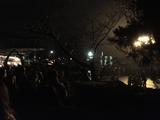 | 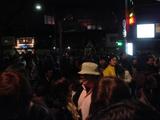 | 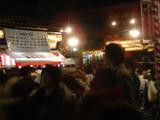 | ||
| 1:00am | 2:00am | 3:00am! |
Amazingly, we weren't done. Exhausted, groggy, and still on a bit of a meat-buzz, we stumbled home through the wooden streets. Mr. Tanaka selected a quaint traditional-style eatery, which became our final stop. We took off our shoes, sat on the cushions and sipped amazake, a warm new year's beverage made from the sweet rice mash left over by the sake-brewing process. Imagine a cross between hot sake and eggnog, and you're not far off. I asked Maiko to translate the fortune I'd drawn.
"Late good luck."
Here we go...
And we round the corner, and suddenly it's temples. Everywhere. Sprawled all over the mountain; we can't even see them all. There's just too many.
I reach for my camera, but it's impossible. I can't take it all in. I'm surrounded by a sea of wooden gates, stone guardians, lanterns, pagodas, stairs that just keep going up.
Don't get lost...
And then, suddenly. Kyomizudera. A temple so large you can't even see it. Because it's built into the mountainside, supported by 139 pillars, and all you can do is stand inside and look out. So we did.
Wanna know what they're looking at?
This.
This is the one, my friends. I have seen the sun reflecting off the gold leaf, I have stood in the serenity of the giant Buddha and walked though the immaculate Zen landscaping, and I am here to tell you: this is the greatest temple in Japan.
The people who built Kyomizudera understood. When you walk along its wooden promenade, look out over the chasm and see the whole city of Kyoto laid out beneath your feet, you can have only one thought:
This is why we build temples.
It was only the morning of my second day in Kyoto, but it was also January 31, which meant there was much to be done. New Year's Day is the number-one holiday in Japan—imagine Christmas, Thanksgiving and the Chinese New Year all rolled into one, and you'll have some idea of how big a deal it is.
The Tanaka family would have probably just slept in if I hadn't been visiting, but we had a lot of sightseeing planned, so the crack of dawn it would be. We split into two groups, with me, Mr. Tanaka, Maiko and Kazuo heading out for another day of temple-gazing, while Mrs. Tanaka and Uena stayed behind to prepare the traditional New Year's Day feast. They would be joining us later on that evening.
A monk-in-training stands watch on the bridge to Gion.
Unlike yesterday, we were going to do the entirety of today's tour on foot, which lent a more organic quality to the proceedings, with each magnificent vista slowly transitioning into the next. First stop, the traditional-yet-chic neighborhood of Gion.
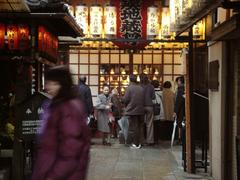 | 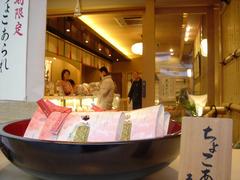 | |
| Traditional. | Chic. |
In America, our idea of a traditional neighboohood involves putting up "Ye Olde Shoppe" signs everywhere, but Japan's got about a millennium of history on us, so their idea of an old-fashioned town is a little bit classier. Actually, it's a lot classier. Intimidatingly so.
It's not just the stores. Even the residential areas look like this.
Named after a Buddhist saint, Gion is the base of operations for the geisha, Japan's famous hostess/entertainers, and their white-faced teenage apprentices, the maiko (no relation to the Tanakas' daughter). Unfortunately for my photographic records, during the hour of 4:00pm, when the streets are filled with silent, kimono-clad women on their way to work, the Tanakas and I were already on the outskirts of town, where Gion gives way to the mountain temples. So, maybe next time. (No shortage of images elsewhere...)
This ain't Fisherman's Wharf.
Gion is popular any day of the year, but this was New Year's Eve, so the streets were just choked. Despite the cold, the district's wooden maze of shops and restaurants teemed with Japanese and gaijin tourists alike, all feeling the buzz of the impending festivities. But it wasn't until we reached the edge of the city, when the marketplace parted to reveal a glimpse of the spendor that awaited us, that I really started to get excited.
This is gonna be big...
Once nice thing about Kyoto is that it's small enough that many of its famous vistas are within walking distance of each other. On our way to the next spot on our list, we passed this cool stockyard of ishidoro stone lanterns. For some reason, I'm crazy about stone lanterns. Even the Tanakas were amused by my enthusiasm.
I guess they're not worried anyone's going to run off with one.
Like Kamakura, Kyoto's less urban areas are served by tiny 2-car trains, essentially unchanged since the turn of the century. The views from these pint-sized locomotives, as they roll down rickety tracks through townships and hillsides, are as quaint as the vehicles themselves. We were about to conclude our tour in Arashiyama, the mountainside town at the western edge of the city. (Kyoto is bounded by three mountain ranges and a river, which ensures that most views of the place include a picturesque backdrop.)
All aboard...
Arashiyama is best experienced in the fall, when it's ablaze with crimson from its hundreds of maple trees, but we were too exhausted for sightseeing at this point, anyway. We were content to unwind over a delicious multi-course meal at one of the area's numerous traditional restaurants. Tofu, it turns out, is a Kyoto specialty—there must've been six different types on my plate alone.
I couldn't help but notice that the whole area reminded me very strongly of some of the mountainside towns I've been to in the States, especially the ones from my film festival days. There's just something about the smaller streets, the brick-and-lumber houses, the enormous green mountainsides cradling it all. It's like I was back in Ashland, Oregon, or even Sundance.
After dinner, Maiko was dying for ice cream (in the middle of winter?), which wasn't a difficult request to fulfill, since there were ice cream shops a-plenty. I was mesmerized by one flavor in particular, a gleaming dark gunmetal-colored confection that stuck out among the strawberries and vanillas. (In its wildest dreams, would Baskin-Robbins shops in the U.S. even consider selling ice cream the color of pencil lead? I think not.) "What on earth is that flavor?" I asked. "Try it," was the response. Turns out it was black-sesame flavor, and yes, it was fantastic.
After which, we headed home, a long moonlit walk along Arashiyama's famous river.
One of Arashiyama's many small shops, still open for business.
And that, ladies and gentlemen, was how I spent my first day in Kyoto.
The guidebooks make no attempt to sugarcoat it: The Japanese may do a great job of preserving the artifacts of their rich cultural heritage, but they're not so great at preserving its spirit. Step outside the gates of Kyoto's most beautiful hallowed grounds, and you're right back in the sea of dirty concrete, brown metal railings and crisscrossing power-lines that define the modern Japanese landscape. The grandeur, the austerity, the resonance of Kyoto's sacred places—they've all been left behind in the country's race for modernization.
The street that runs past Kinkaku-ji.
Books like Dogs & Demons wallow in despair at what has been lost, but I tend to believe that this is just another round in Japan's repeated cycle of isolation followed by semi-voluntary internationalism. Japan has survived and flourished each time; no doubt their renaissance will come again. Perhaps this is one of the functions these magnificent temples serve: to remind the Japanese of their potential.
If Kinkaku-ji is famous for its gleaming exterior, then Ryoan-ji is surely just as famous for its inner beauty, as it houses the most famous Zen rock garden in the world. Nearly 100 feet wide, the garden consists of 15 stones in a bed of white gravel which is raked every morning. One of its most amazing features is that the rocks have been arranged in such a way that only 14 of them can be viewed from any vantage point.
All photos of the rock garden look exactly like this one. This is the only spot where you can photograph it.
A view from outside the nearby teahouse.
Folks, I have a confession to make. The garden just didn't do much for me. It's not the rocks' fault. Other visitors have been humbled to the core by this place, but I was freezing, tired and a little templed out after taking 80 photos of Kinkaku-ji. More to the point, the garden was so crowded with tourists that there was literally nowhere I could sit—these just weren't the right conditions for enlightenment. But that's okay. When I come back, the garden will still be there, waiting.
The key to every great monument is a long buildup.
Man, this better be good...
Ah.
To many, Kinkaku-ji is the number-one attraction in Kyoto. A gold-covered temple, each floor representing a different historical architectural style, sitting atop a mirror-like pond. It was constructed as a sort of retirement palace in the late 1300s by the shogun Yoshimitsu, but was converted to a Buddhist temple after his death, in accordance with his will.
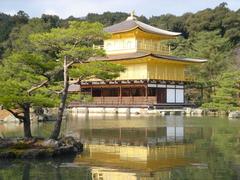 | 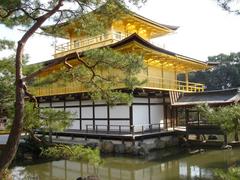 | |
| Don't you think it kinda looks like a miniature in this shot? Weird, huh. | Yup. Pretty stunning from any angle. |
In 1950, the whole of Japan was shocked when a young monk burnt the building to the ground, an event later fictionalized by famed poet Yukio Mishima. It was, needless to say, quickly rebuilt. The pamphlets kinda skip over this part, for some reason.
The golden pavilion is only one of the site's attractions. As you wander around the winding pathways, you'll encounter a tiny island featuring an even tinier pagoda. This is the Hakuja-no-tsuka, or "mound of the white snake." It pays tribute to the serpent guardian of the temple waters.
You can see four Buddhas carved into the base of the stone.
A magnificent tea garden lies just beyond that, and visitors are encouraged to sit and enjoy some frothy green tea, which was just what I needed on a cold December afternoon.
Do you even need to ask how good the tea was?
Though I imagine it probably won't come up very often, if you're ever offered the opportunity to choose between an airplane and a train that can travel at 200 mph, take the train.
It's the future of travel, I tell you.
Yes, I am a convert to Japan's world-renowned Shinkansen, the sleek high-speed transport whose name means "New main line." Okay, so it's not a very impressive name. But after a lifetime of cross-country plane rides, I can safely say that everything else about it is mighty impressive indeed.
I know what you're thinking. "But a plane travels so much faster! A train would take twice as long."
Ah, but you forget the Japanese culture of efficiency. Your actual plane trip may take three hours, but you also have to add the time you spend parking, checking your bags, slogging through Security, waiting to board, sitting on the runway... need I go on?
Don't bother showing up half-an-hour early for your Shinkansen. It doesn't even arrive until about five minutes before you're scheduled to leave. There's no line because passengers can board through any of the 16 doors. Step on, stow your bag, and sit down. Or don't. Feel free to get up and wander around. I found a nice big window between cars and snapped some shots of the city as it sped by.
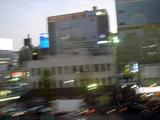 | 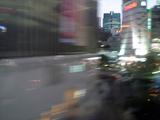 | 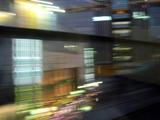 | ||
| Wheee | eeeeee | eeeeeeeee! |
Yeah, that's right. I finally got a real camera. It's Sony's latest fetish object, the DSC-T1, a 5-megapixel camera smaller than a pack of cigarettes. If they ever sell it in the U.S., I highly recommend picking one up. Now, I'm not exactly swimming in money over here, but a trip to Kyoto is a once-in-a-lifetime experience, and, well, apparently some of you think I take decent photos, so...
Anyway, the 105-minute train ride flew by so fast it wasn't even funny. Maybe the sensation of watching the landscape whiz by gives one a fuller sense of traveling, I dunno. But it felt nothing like a 105-minute plane ride. The Shinkansen doesn't drone loudly like a plane, it has a futuristic hum I associate with sci-fi movies. The air was fresh, the bathrooms were roomy and I never want to fly on an airplane again.
No seatbelts, no turbulence, and the seats lean way back. WAY back.
I was greeted in Kyoto by Mr. Tanaka, a friend of my dad's. The Tanakas lived in Chapel Hill for almost as long as I did, and their daughter went to university in Connecticut, so there was no culture shock and no real language barrier. It was really an adventure for everyone, since my visit gave the family an excuse to visit all the historic places in Kyoto that they hadn't gotten around to visiting themselves. Though the Tanakas promised an elaborate Japanese-style New Year's celebration at Heian Jingu Shrine, followed by the traditional feast, they sheepishly admitted that they'd normally just be spending the New Year watching TV.
The Tanakas (clockwise from left): Maiko, Kazuo, daughter-in-law Uena, Toshiyuki, Sakiko.
My camera holds about 100 photos at max resolution, and I filled it up almost every day I was there. In the entries that follow, I'll share some of the highlights of my excursions, which took me to virtually every major sightseeing spot in Kyoto.

